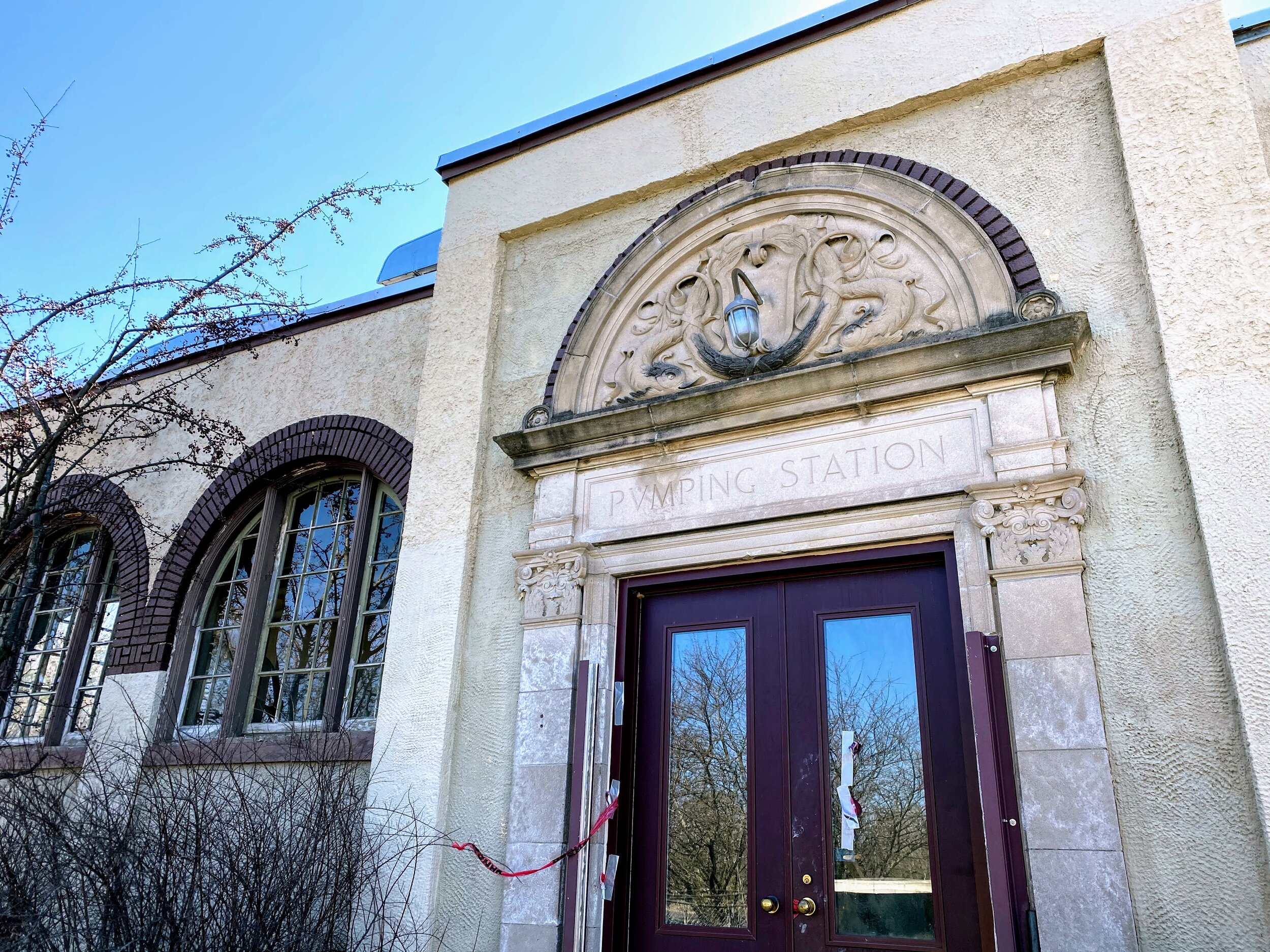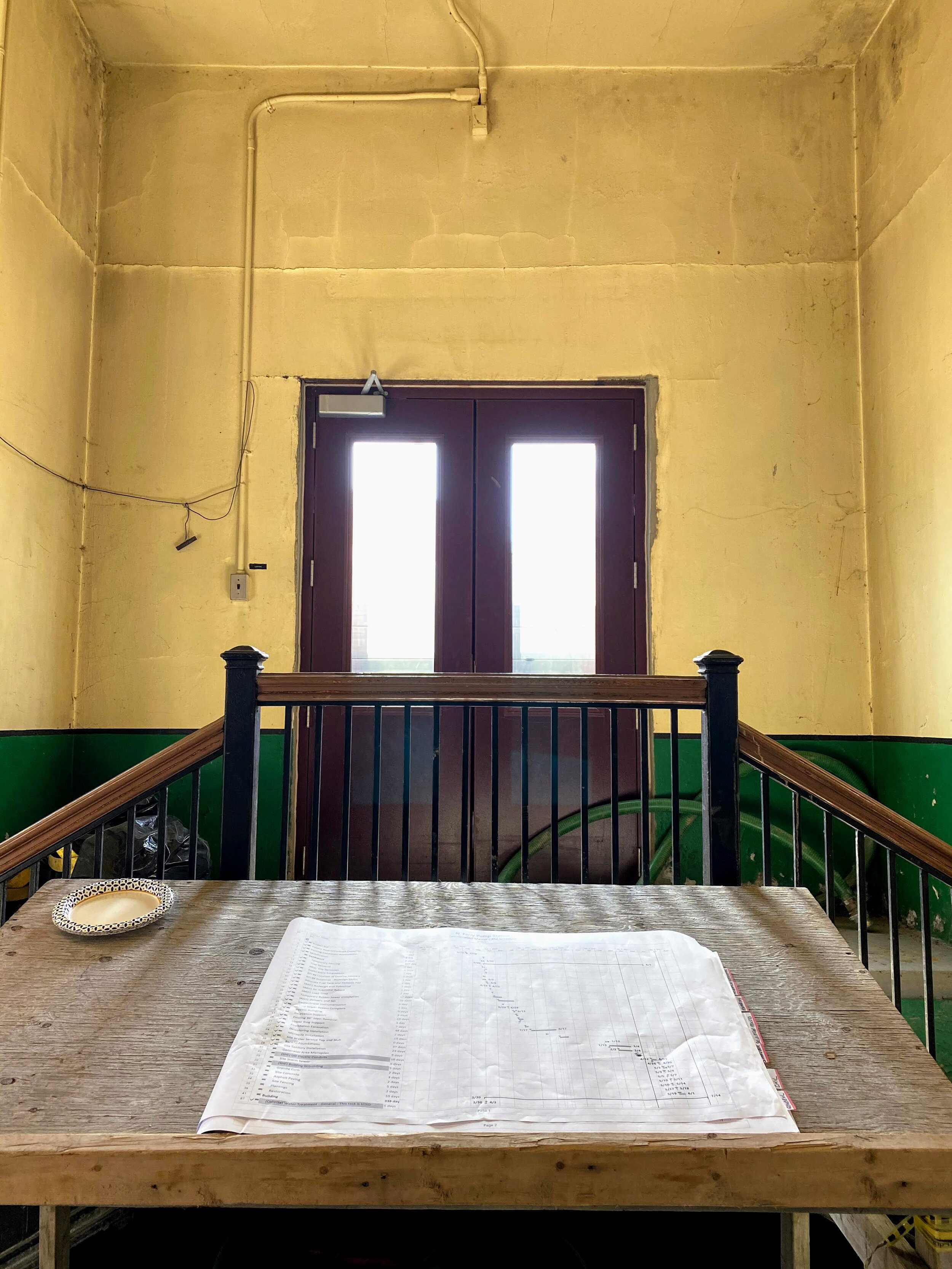Exploring New Uses for an Old Pump Station
A closeup photo of the front facade of the pump station. You can see one pair of arched windows and the highly decorated entryway. “PVMPING STATION” is carved into the lintel.
I had walked past the Schenectady Stockade Pump Station dozens of times, and something about it really captured my imagination. I don’t think that had ever been the case with a waste treatment facility, but there’s something about this one that seems special. First, it’s situated in Riverside Park right on the Mohawk River, a prime walking path located in the historic Stockade neighborhood. Second, it’s quite a lovely building. Seen from the walking path you can admire its arched windows, the ionic pilasters framing the doorway, and the arch pediment featuring two happy-looking fish. Its position in the park meant it was not competing with any other buildings for visibility and, for at least as long as I have lived in Schenectady, the fact that it was fenced off made me all the more curious about what was going on in there.
When the League announced the recipients of the 2020 Technical Assistance Grants (a New York State Council on the Arts regrant partnership program), I was excited to see the Pump Station listed among them. A sidenote: truly, every project the League has a hand in is exciting in its own way, but not all of them are so accessible. Site visits have been virtually nonexistent since COVID hit in March 2020, and traveling is difficult. When a project pops up in my backyard, it’s a rare opportunity to see a site in real life and meet the people behind it.
I reached out to Suzanne Unger, President of the Stockade Association, and asked if I might be able to plan a site visit and hear more about the feasibility study their Technical Assistance Grant will be funding. She graciously invited me to meet her along with Carol DeLaMarter, former Stockade Association President, and Gloria Kishton, Chair of Schenectady Heritage Foundation. All three women are longtime residents of the Stockade and are dedicated to promoting and preserving their neighborhood.
Interior photos of the pump station. You can find a video tour of the site on our Instagram page, saved in our highlights as “Schdy Pump.”
The Pump Station was built in 1913 and is a contributing property in the Stockade Historic District, meaning that it adds to the historic integrity of the district. The Stockade was the first local historic district designated in New York State (1962) and it was added to the National Register of Historic Places in 1973. Its 82 acres have been continuously inhabited for over 300 years, boasting a great variety of historic buildings from the 17th- to the early 20th-century. The National Park Service notes that the Stockade has the “highest concentration of historic period homes in the country.” The district is also located in a floodplain and has suffered severe flooding over the years. The League included the Stockade on the 2016-2017 Seven to Save list for exactly this reason. This is also why the historic Pump Station is being decommissioned — the electrical systems failed after damage from Hurricane Irene in 2011. It was determined that a new facility was needed to better handle the station’s needs. An article from late last year in The Daily Gazette noted that “the present facility collects between 4 and 6 million gallons of waste each day, from not only the city, but also the Village of Scotia and industrial parks in Rotterdam and Glenville.” Once construction on the new plant is complete, the historic pump station will be officially decommissioned.
A drone photo showing an aerial view of the construction zone, before the new building began taking shape. On the left you see the historic building, to the right there is a 40-foot-deep pit on top of which the new pump station is being built.
Photo courtesy of Gloria Kishton.
The most recent rendering of this project from 2017. From the Stockade Association website: “The final plan adopted for construction in 2019 is different from the 2017 with the placement of the new building and underground infrastructure at an increased distance from the old pump house more toward the top and right of this rendering by several feet.“
With construction of a new pump station well underway, the question of what to do with the old building remains. As we walked through the Stockade, I asked the group if they had anything specific they were hoping the building could become — a visitor center, maybe? Gloria declared that “our minds are open.” Keeping the building a community asset is the priority, whatever form that might take.
This photocopy of an old black and white photograph is the one Andy Coppola pointed out as being part of GE promotions, showing off the technology being used in Schenectady.
The pump station office is on the second floor and contains numerous blueprints of the building and its mechanics.
This blueprint shows the design for the stairwell leading up to the second floor office, installed after the building was constructed.
When we arrived at the Pump Station, we were met by Andy Coppola, Plant Manager for the City of Schenectady. He has spent considerable time in the building and it showed in his collection of anecdotes. He told us about how in the early days, the local weatherman would call the plant manager (who had clear views over the Mohawk) to get the weather report. He showed off an old photograph of the building’s interior that he said GE used as a promotional tool all over the world. He pulled out old ledgers and blueprints — over a century of historical documents the group was keen to look through and figure out a way to preserve.
An archival postcard image showing the pump station at the time it hosted a bandstand on its roof. It reads: “Concrete Pumping Station / and Band Stand / Schenectady, N.Y. / City Engineer W. Thomas Wooley / Contractor Keith O. Guthrie” This image was featured in the January 2017 issue of the Stockade Spy.
Andy also talked about the Pump Station’s alternate life in the 1940s-50s. Apparently, it was a simple pump station by day, but a lively bandstand by night. Open air, music, and those river views — sounds like a happening place to me. Could the pump station’s next life take a cue from its past? A bandstand probably isn’t in the cards, but it’s fun to think about.
And that’s exactly what the City of Schenectady and Stockade advocates will be doing. The TAG-funded feasibility study will be completed by Marilyn Kaplan and it will guide the City in determining how the site might be best adapted to suit current needs. The report will determine the condition of the building and what code updates may be needed. Flood mitigation efforts will be taken into consideration as options are explored.
It’s certainly not your typical adaptive reuse project, but the overwhelming community support along with its location make it an interesting one. Its site on the river means it is accessible not just to the Stockade neighborhood, but also the Mohawk-Hudson Bike Trail, Erie Canalway National Heritage Corridor, and a short distance to other cultural and historic resources in the city. Preserving the pump station is important to maintaining the historic fabric of the neighborhood. Finding a way to make it an active community resource will benefit locals and tourists alike.
We’ll be keen to see what insights the “Historic Stockade 1913 Pump Station Feasibility Reuse Study” will provide, and we’ll be sure to share updates as this project moves forward. In the meantime, I’m curious — in your wildest imagination, what would you turn this building into?






